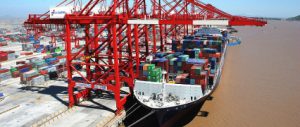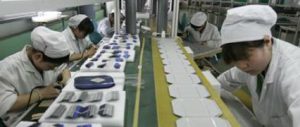It’s a deep pit in the Mojave desert. But it could hold the key to America challenging China’s technological domination of the 21st century.
At the bottom of the vast site in the American west, beneath six metres of bright emerald-green water, runs a rich seam of ores that are hardly household names but are rapidly emerging as the building blocks of the high-tech future.
The mine – in south-eastern California, near the Nevada border — is the largest known deposit of rare-earth elements outside China. Eight years ago, it was shut down in a tacit admission that the United States was ceding the market to China. Now, the owners have secured final approval to restart operations, and hope to begin production soon.
"We will probably never be the largest [mine] in the world again. It will be hard to overcome China’s status in that regard, but we do think we will be a very significant supplier," Mark Smith, chief executive of Molycorp Minerals, which owns the mine, told reporters during a tour of the site.
So far as the Obama administration is concerned, the mine can’t open soon enough. A US department of energy report warned on 15 December 2010 that, in the absence of mines such as this one, America risks losing control over the production of a host of technologies, from smart phones to smart bombs, electric-car batteries to wind turbines, because of a virtual Chinese monopoly on the rare-earth metals essential to their production.
China controls 97% of global rare-earth metals production. Such total domination of a strategic resource became impossible to ignore last October when China cut exports of rare-earth elements by more than 70% over the previous year, disrupting manufacturing in Japan, Europe and the United States. Prices of even the cheapest of the 17 rare-earth elements rose 40%.
Now America, like Japan and Europe, is desperate to find alternatives. "Reopening domestic production is an important part of a globalised supply chain," David Sandalow, the energy department’s assistant secretary for international affairs told a seminar in Washington.
For Smith, the official recognition of the strategic importance of the metals was a long time coming. "I’ve been going out to Washington DC every other week for about two years trying to tell the rare-earths story," he said.
They are listening in Washington now. At the 15 December seminar at the Centre for Strategic and International Studies, one PowerPoint presentation lingered on a slide that showed only the Chinese flag. The room filled with nervous laughter.
By 2015, global demand for rare earths is expected to reach 205,000 tonnes. "If we don’t get alternative supplies up and running, we are going to have this supply gap that is going to cause a lot of issues," Smith said.
Those issues forced their way onto the government’s agenda last autumn when China began squeezing raw material exports of rare-earth minerals.
Some US media reports have speculated that China is trying to use its control over the supply lines for political leverage. But a number of analysts say China is trying to get better control over an expensive, dirty and dangerous mining process, and to get more factories to set up shop inside the country.
Rare earths are extracted through opencast mining and generate radioactive waste.
"I don’t believe that China is trying to chop the west off at the knees, but it has a growing internal market that is driving the demand," said Gareth Hatch, an analyst at Technology Metal Research. "That reduces the amount they are willing to export." That is where Molycorp – the frontrunner for now in a global race to develop alternative production of rare-earth materials – hopes to step in.
Since going public last July, the company has raised more than US$500 million to expand its production facilities at Mountain Pass, California, a collection of rusting buildings that date from the 1950s. In December, Sumitomo Corporation of Japan invested US$130 million in return for guaranteed supplies of rare earths for the next seven years. The company also has applied for department of energy loans.
By mid-2012, Molycorp aims to produce 20,000 tonnes a year of nine of the 17 rare earths or about 25% of current western imports from China. Smith suggested the company could possibly ramp up production to 40,000 tonnes within the next 18 months. He says Molycorp has exposed just 55 acres (just over 22 hectares) of the 2,200 acre (890-hectare) site.
But even production on that scale may not be enough to guarantee the supply of metals needed to move to a clean energy economy: lanthanum for batteries for hybrid cars; neodymium for the permanent magnets for wind turbines, especially offshore; europium for energy efficient lighting.
"You would need seven mines the size of Molycorp’s just to meet the demand for wind turbines and that would mean no neodymium for motors or any other applications," said Jim Hedrick, who until 2009 was the rare-earth expert at the US Geological Survey.
"Obviously there is a demand for 10 or 20 mines through the world to meet all the different demands for these products."
Some companies, such as General Electric, are already moving to reduce their use of rare earths. "What we are going to absolutely have to do is diversify our sources and optimise the use of these materials in manufacturing," said Steve Duclos, who heads GE’s global research division.
In Japan, meanwhile, Hitachi has started a recycling effort to recover rare earths from hard drives and other materials.
Aside from raw materials, it is also unclear whether the United States still has the expertise for the complicated process of turning minerals into usable clean-tech components.
Such challenges were unthinkable half-a-century ago when prospectors looking for uranium stumbled instead on a rich deposit of rare earths about an hour’s drive from Las Vegas, Nevada.
By the 1960s, the mine was booming, largely through sales of europium, used to produce the bright red tones of colour televisions.
But prices fell as China came on the market, with its low production costs. A pipeline accident in the late 1990s, which leaked radioactive fluid into the desert and a nearby town, led to an expensive clean-up.
The mine closed in 2002. The central pit in the 55-acre (22.3-hectare) site became a pool of bright green water. White bales of minerals – some mined eight years ago – were stockpiled until such time as prices would rise.
This time around, however, Molycorp says it has a fighting chance against China, especially if it is able to meet its goal of complete mines-to-magnet processing at the Mountain Pass facility.
The company is also confident it can head off competition from a slew of new mines due to begin coming online from Australia, Wyoming, Quebec and South Africa. "The growth in demand for these minerals is just phenomenal," Smith said. "A 6% average growth rate for us would be very, very good; but when you start adding things like hybrid vehicles and wind turbines to the rare-earth sectors, now you are talking about double-digit growth, and you still don’t know where that will end."
At this point, though, Molycorp is not even at the beginning. "The road to the green world of the future starts from the black earth. But first you have to get the materials out of the ground," said Hatch. "The whole clean-tech energy industry is hinging on it."
Copyright © Guardian News and Media Limited 2011
US Department of Agriculture photo by Peggy Greb, from Wikipedia, shows rare-earth oxides

